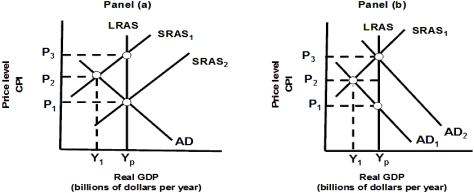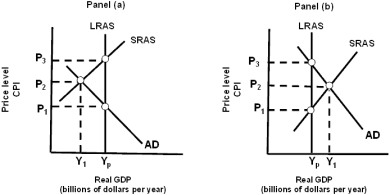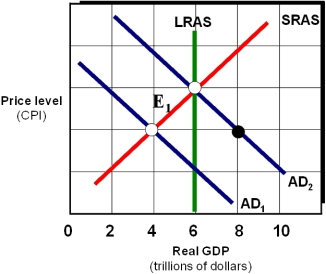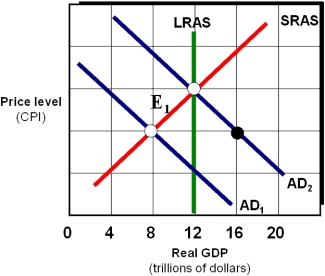Deck 20: A: Appendix: Policy Disputes Using the Self-Correcting Aggregate Demand and Supply Model
Question
Question
Question
Question
Question
Question
Question
Question
Question
Question
Question
Question
Question
Question
Question
Question
Question
Question
Question
Question
Question
Question
Question
Question
Question
Question
Question
Question
Question
Question
Question

Unlock Deck
Sign up to unlock the cards in this deck!
Unlock Deck
Unlock Deck
1/31
Play
Full screen (f)
Deck 20: A: Appendix: Policy Disputes Using the Self-Correcting Aggregate Demand and Supply Model
1

Assume that the economy depicted in Panel (a)of Exhibit 20A-1 is in short-run equilibrium where AD equals SRAS₁.If the economy is left to correct itself according to classical theory:
A) wages will fall as long as real GDP is above Yp.
B) lower wages will result in a shift from SRAS₁ to SRAS₂.
C) long-run equilibrium will be established at Yp and P₃.
D) all of the above will take place.
B
2
Assuming the economy is experiencing a recessionary gap,classical economists predict that:
A) wages will remain fixed.
B) monetary policy will sell government securities.
C) higher wages will shift the short-run aggregate supply curve leftward.
D) lower wages will shift the short-run aggregate supply curve rightward.
E) none of the above.
A) wages will remain fixed.
B) monetary policy will sell government securities.
C) higher wages will shift the short-run aggregate supply curve leftward.
D) lower wages will shift the short-run aggregate supply curve rightward.
E) none of the above.
D
3
Assume the economy is in short-run equilibrium at a real GDP above its potential real GDP.According to classical theory,which of the following policies should be followed?
A) The Federal Reserve should use open market operations and buy U.S. government securities.
B) The Federal Reserve should not follow a fixed rule.
C) The federal government should cut taxes.
D) Fiscal policy and monetary policy should not be activist.
A) The Federal Reserve should use open market operations and buy U.S. government securities.
B) The Federal Reserve should not follow a fixed rule.
C) The federal government should cut taxes.
D) Fiscal policy and monetary policy should not be activist.
D
4
A policy to do nothing and allow the economy to self-correct or adjust without interference from the federal government is also called a(n)____ policy:
A) nonintervention
B) active
C) stabilization
D) fixed rule
A) nonintervention
B) active
C) stabilization
D) fixed rule

Unlock Deck
Unlock for access to all 31 flashcards in this deck.
Unlock Deck
k this deck
5
Assume the economy is in short-run equilibrium at a real GDP below its potential real GDP.According to Keynesian theory,which of the following policies should be followed?
A) The Federal Reserve should increase the money supply.
B) The federal government should increase spending.
C) The federal government should do nothing because the economy will self correct to potential real GDP.
D) All of the above.
A) The Federal Reserve should increase the money supply.
B) The federal government should increase spending.
C) The federal government should do nothing because the economy will self correct to potential real GDP.
D) All of the above.

Unlock Deck
Unlock for access to all 31 flashcards in this deck.
Unlock Deck
k this deck
6
Exhibit 20A-2 Macro AD/AS Models

In Panel (a)of Exhibit 20A-2,an expansionary Keynesian government stabilization policy designed to move the economy from Y₁ to Yp would shift the:
A) aggregate demand curve (AD)to the left.
B) aggregate demand curve (AD) to the right.
C) SRAS rightward.
D) LRAS rightward.

In Panel (a)of Exhibit 20A-2,an expansionary Keynesian government stabilization policy designed to move the economy from Y₁ to Yp would shift the:
A) aggregate demand curve (AD)to the left.
B) aggregate demand curve (AD) to the right.
C) SRAS rightward.
D) LRAS rightward.

Unlock Deck
Unlock for access to all 31 flashcards in this deck.
Unlock Deck
k this deck
7
Exhibit 20A-2 Macro AD/AS Models

In Panel (a)of Exhibit 20A-2,the economy is initially in short-run equilibrium at real GDP level Y₁ and price level P₂.If the federal government or Fed decides to intervene,it would most likely:
A) increase taxes.
B) decrease the money supply.
C) increase the level of government spending for goods and services.
D) decrease the level of government spending for goods and services.

In Panel (a)of Exhibit 20A-2,the economy is initially in short-run equilibrium at real GDP level Y₁ and price level P₂.If the federal government or Fed decides to intervene,it would most likely:
A) increase taxes.
B) decrease the money supply.
C) increase the level of government spending for goods and services.
D) decrease the level of government spending for goods and services.

Unlock Deck
Unlock for access to all 31 flashcards in this deck.
Unlock Deck
k this deck
8
Assume the economy is experiencing a recessionary gap.Keynesian economists would support which of the following policies:
A) Nonstabilization
B) Expansionary
C) Nonintervention
D) Fixed wage
A) Nonstabilization
B) Expansionary
C) Nonintervention
D) Fixed wage

Unlock Deck
Unlock for access to all 31 flashcards in this deck.
Unlock Deck
k this deck
9
Assume the economy is operating at a real GDP above full-employment real GDP.Keynesian economists would prescribe which of the following policies?
A) Nonintervention
B) Fixed rule
C) Contractionary
D) Expansionary
A) Nonintervention
B) Fixed rule
C) Contractionary
D) Expansionary

Unlock Deck
Unlock for access to all 31 flashcards in this deck.
Unlock Deck
k this deck
10
Assume the economy is experiencing an inflationary gap,classical economists believe that:
A) flexible wages will restore full employment.
B) the federal government should decrease spending to shift the aggregate demand curve leftward.
C) the Federal Reserve should lower the interest rate.
D) the federal government should increase spending to shift the aggregate demand curve rightward.
A) flexible wages will restore full employment.
B) the federal government should decrease spending to shift the aggregate demand curve leftward.
C) the Federal Reserve should lower the interest rate.
D) the federal government should increase spending to shift the aggregate demand curve rightward.

Unlock Deck
Unlock for access to all 31 flashcards in this deck.
Unlock Deck
k this deck
11

In Panel (a)of Exhibit 20A-1,the economy is initially in short-run equilibrium at real GDP level Y₁ and price level P₂.Classical theory argues:
A) the federal government must shift AD₁ to AD₂ as shown in Panel (b).
B) the federal government must shift SRAS₁ to SRAS₂.
C) that SRAS₁ will shift to SRAS₂ without government intervention.
D) that AD will shift rightward without government intervention.

Unlock Deck
Unlock for access to all 31 flashcards in this deck.
Unlock Deck
k this deck
12
Exhibit 20A-2 Macro AD/AS Models

In Panel (b)of Exhibit 20A-2,the economy is initially in short-run equilibrium at real GDP level Y₁ and price level P₂.If the federal government or Fed decides to intervene,it would most likely:
A) decrease taxes.
B) increase the money supply.
C) increase the level of government spending for goods and services.
D) decrease the level of government spending for goods and services.

In Panel (b)of Exhibit 20A-2,the economy is initially in short-run equilibrium at real GDP level Y₁ and price level P₂.If the federal government or Fed decides to intervene,it would most likely:
A) decrease taxes.
B) increase the money supply.
C) increase the level of government spending for goods and services.
D) decrease the level of government spending for goods and services.

Unlock Deck
Unlock for access to all 31 flashcards in this deck.
Unlock Deck
k this deck
13
Exhibit 20A-2 Macro AD/AS Models

In Panel (b)of Exhibit 20A-2,the economy is initially in short-run equilibrium at real GDP level Y₁ and price level P₂.Classical theory argues that:
A) SRAS will shift to leftward and establish full employment at P₃Yp without government intervention.
B) higher wages will result in a leftward shift of SRAS.
C) long-run equilibrium will be established at Yp and P₃.
D) all of the above will take place.

In Panel (b)of Exhibit 20A-2,the economy is initially in short-run equilibrium at real GDP level Y₁ and price level P₂.Classical theory argues that:
A) SRAS will shift to leftward and establish full employment at P₃Yp without government intervention.
B) higher wages will result in a leftward shift of SRAS.
C) long-run equilibrium will be established at Yp and P₃.
D) all of the above will take place.

Unlock Deck
Unlock for access to all 31 flashcards in this deck.
Unlock Deck
k this deck
14
Exhibit 20A-2 Macro AD/AS Models

In Panel (a)of Exhibit 20A-2,the economy is initially in short-run equilibrium at real GDP level Y₁ and price level P₂.Classical theory argues that:
A) SRAS will shift to leftward and establish full employment at P₃Yp without government intervention.
B) higher wages will result in a leftward shift of SRAS.
C) long-run equilibrium will be established at Yp and P₁.
D) all of the above will take place.

In Panel (a)of Exhibit 20A-2,the economy is initially in short-run equilibrium at real GDP level Y₁ and price level P₂.Classical theory argues that:
A) SRAS will shift to leftward and establish full employment at P₃Yp without government intervention.
B) higher wages will result in a leftward shift of SRAS.
C) long-run equilibrium will be established at Yp and P₁.
D) all of the above will take place.

Unlock Deck
Unlock for access to all 31 flashcards in this deck.
Unlock Deck
k this deck
15
Assuming the economy is in a recession,Keynesian economists predict that:
A) wages will remain fixed.
B) monetary policy will sell government securities.
C) higher wages will shift the short-run aggregate supply curve leftward.
D) lower wages will shift the short-run aggregate supply curve rightward.
A) wages will remain fixed.
B) monetary policy will sell government securities.
C) higher wages will shift the short-run aggregate supply curve leftward.
D) lower wages will shift the short-run aggregate supply curve rightward.

Unlock Deck
Unlock for access to all 31 flashcards in this deck.
Unlock Deck
k this deck
16
Assume the economy is operating at a real GDP above full-employment real GDP.Classical economists would prescribe which of the following policies?
A) Nonintervention
B) Active monetary policy
C) Contractionary
D) Expansionary
A) Nonintervention
B) Active monetary policy
C) Contractionary
D) Expansionary

Unlock Deck
Unlock for access to all 31 flashcards in this deck.
Unlock Deck
k this deck
17
Classical theory advocates ____ policy and Keynesian theory advocates ____ policy.
A) nonintervention; intervention
B) active; nonstabilization
C) stabilization; fixed wage
D) fixed rule; passive
A) nonintervention; intervention
B) active; nonstabilization
C) stabilization; fixed wage
D) fixed rule; passive

Unlock Deck
Unlock for access to all 31 flashcards in this deck.
Unlock Deck
k this deck
18

Assume that the economy depicted in Panel (b)of Exhibit 20A-1 is in short-run equilibrium where AD₁ equals SRAS₁.Keynesian theory argues:
A) nominal wages will fall as long as employment remains above the natural level of unemployment.
B) lower wages will result in a shift from SRAS₁ to SRAS₂.
C) long-run equilibrium will be established at Yp and P₁.
D) government intervention must shift AD₁ rightward to AD₂.

Unlock Deck
Unlock for access to all 31 flashcards in this deck.
Unlock Deck
k this deck
19

In Panel (b)of Exhibit 20A-1,the economy is initially in short-run equilibrium at real GDP level Y₁ and price level P₂.If the federal government decides to intervene,it would most likely:
A) increase taxes.
B) decrease the money supply.
C) increase the level of government spending for goods and services.
D) decrease the level of government spending for goods and services.

Unlock Deck
Unlock for access to all 31 flashcards in this deck.
Unlock Deck
k this deck
20
Exhibit 20A-2 Macro AD/AS Models

As shown in Panel (a)of Exhibit 20A-2,assume the economy adopts a classical nonintervention policy.Which of the following would cause the economy to self-correct?
A) Competition among firms for workers increases the nominal wage and SRAS shifts rightward.
B) Long-run equilibrium will be established at Y₁ and P₂.
C) Long-run equilibrium will be established at Y₁ and P₃.
D) Competition among unemployed workers decreases nominal wages and SRAS shifts rightward.

As shown in Panel (a)of Exhibit 20A-2,assume the economy adopts a classical nonintervention policy.Which of the following would cause the economy to self-correct?
A) Competition among firms for workers increases the nominal wage and SRAS shifts rightward.
B) Long-run equilibrium will be established at Y₁ and P₂.
C) Long-run equilibrium will be established at Y₁ and P₃.
D) Competition among unemployed workers decreases nominal wages and SRAS shifts rightward.

Unlock Deck
Unlock for access to all 31 flashcards in this deck.
Unlock Deck
k this deck
21
Exhibit 20A-3 Macro AD/AS Model

As shown in Exhibit 20A-3,assume the marginal propensity to consume MPC equals 0.80.Using discretionary fiscal policy,federal government spending should be ____ in order to restore the economy from E₁ to full employment.
A) increased by $2 trillion
B) decreased by $2 trillion
C) decreased by $.40 trillion
D) increased by $.40 trillion
E) increased by $.80 trillion

As shown in Exhibit 20A-3,assume the marginal propensity to consume MPC equals 0.80.Using discretionary fiscal policy,federal government spending should be ____ in order to restore the economy from E₁ to full employment.
A) increased by $2 trillion
B) decreased by $2 trillion
C) decreased by $.40 trillion
D) increased by $.40 trillion
E) increased by $.80 trillion

Unlock Deck
Unlock for access to all 31 flashcards in this deck.
Unlock Deck
k this deck
22
Exhibit 20A-2 Macro AD/AS Models

In Panel (b)of Exhibit 20A-2,a Keynesian expansionary stabilization policy designed to move the economy from Y₁ to Yp would attempt to shift the:
A) aggregate demand curve (AD) leftward.
B) SRAS curve leftward.
C) aggregate demand curve (AD) rightward.
D) LRAS curve rightward.

In Panel (b)of Exhibit 20A-2,a Keynesian expansionary stabilization policy designed to move the economy from Y₁ to Yp would attempt to shift the:
A) aggregate demand curve (AD) leftward.
B) SRAS curve leftward.
C) aggregate demand curve (AD) rightward.
D) LRAS curve rightward.

Unlock Deck
Unlock for access to all 31 flashcards in this deck.
Unlock Deck
k this deck
23
Exhibit 20A-3 Macro AD/AS Model

As shown in Exhibit 20A-3,assume the marginal propensity to consume MPC equals 0.75.Using discretionary fiscal policy,federal government spending should be ____ in order to restore the economy from E₁ to full employment.
A) increased by $1 trillion
B) increased by $2 trillion
C) decreased by $2 trillion
D) increased by $.50 trillion
E) increased by $.80 trillion

As shown in Exhibit 20A-3,assume the marginal propensity to consume MPC equals 0.75.Using discretionary fiscal policy,federal government spending should be ____ in order to restore the economy from E₁ to full employment.
A) increased by $1 trillion
B) increased by $2 trillion
C) decreased by $2 trillion
D) increased by $.50 trillion
E) increased by $.80 trillion

Unlock Deck
Unlock for access to all 31 flashcards in this deck.
Unlock Deck
k this deck
24
If the economy is not operating at full-employment real GDP,classical economists prescribe a government policy of nonintervention.

Unlock Deck
Unlock for access to all 31 flashcards in this deck.
Unlock Deck
k this deck
25
Exhibit 20A-4 Macro AD/AS Model

As shown in Exhibit 20A-4,assume the marginal propensity to consume MPC equals 0.80.Using discretionary fiscal policy,federal government spending should be ____ in order to restore the economy from E₁ to full employment.
A) increased by $1.6 trillion
B) decreased by $1.6 trillion
C) increased by $.20 trillion
D) increased by $.20 trillion
E) increased by $.80 trillion

As shown in Exhibit 20A-4,assume the marginal propensity to consume MPC equals 0.80.Using discretionary fiscal policy,federal government spending should be ____ in order to restore the economy from E₁ to full employment.
A) increased by $1.6 trillion
B) decreased by $1.6 trillion
C) increased by $.20 trillion
D) increased by $.20 trillion
E) increased by $.80 trillion

Unlock Deck
Unlock for access to all 31 flashcards in this deck.
Unlock Deck
k this deck
26
Assuming an inflationary gap exists,classical economists believe that flexible wages will restore full employment.

Unlock Deck
Unlock for access to all 31 flashcards in this deck.
Unlock Deck
k this deck
27
Exhibit 20A-2 Macro AD/AS Models

As shown in Panel (b)of Exhibit 20A-2,assume the economy adopts a classical nonintervention policy.Which of the following would cause the economy to self-correct?
A) Competition among firms for workers increases the nominal wage and SRAS shifts rightward.
B) Long-run equilibrium will be established at Y₁ and P₂.
C) Long-run equilibrium will be established at Yp and P₃.
D) Competition among unemployed workers decreases nominal wages and SRAS shifts rightward.

As shown in Panel (b)of Exhibit 20A-2,assume the economy adopts a classical nonintervention policy.Which of the following would cause the economy to self-correct?
A) Competition among firms for workers increases the nominal wage and SRAS shifts rightward.
B) Long-run equilibrium will be established at Y₁ and P₂.
C) Long-run equilibrium will be established at Yp and P₃.
D) Competition among unemployed workers decreases nominal wages and SRAS shifts rightward.

Unlock Deck
Unlock for access to all 31 flashcards in this deck.
Unlock Deck
k this deck
28
Exhibit 20A-4 Macro AD/AS Model

As shown in Exhibit 20A-4,assume the marginal propensity to consume MPC equals 0.75.Using discretionary fiscal policy,federal government spending should be ____ in order to restore the economy from E₁ to full employment.
A) increased by $.25 trillion
B) decreased by $.25 trillion
C) decreased by $2 trillion
D) increased by $2 trillion
E) increased by $1 trillion

As shown in Exhibit 20A-4,assume the marginal propensity to consume MPC equals 0.75.Using discretionary fiscal policy,federal government spending should be ____ in order to restore the economy from E₁ to full employment.
A) increased by $.25 trillion
B) decreased by $.25 trillion
C) decreased by $2 trillion
D) increased by $2 trillion
E) increased by $1 trillion

Unlock Deck
Unlock for access to all 31 flashcards in this deck.
Unlock Deck
k this deck
29
If the economy is experiencing an inflationary gap,classical economists argue that the Federal Reserve should lower interest rates.

Unlock Deck
Unlock for access to all 31 flashcards in this deck.
Unlock Deck
k this deck
30
If the economy is experiencing an inflationary gap,Keynesian economists advocate allowing flexible wages to shift the short-run aggregate supply curve (SRAC)upward and restore full employment.

Unlock Deck
Unlock for access to all 31 flashcards in this deck.
Unlock Deck
k this deck
31
Assuming the economy is in a recession,Keynesian economists predict that lower wages will shift the short-run aggregate supply curve rightward.

Unlock Deck
Unlock for access to all 31 flashcards in this deck.
Unlock Deck
k this deck


